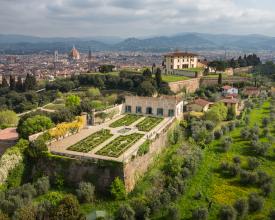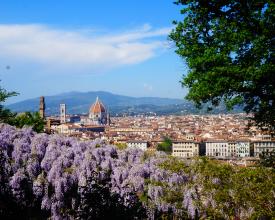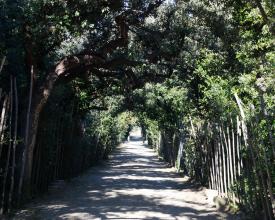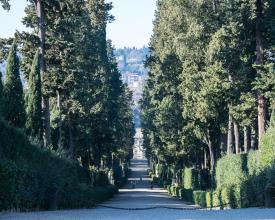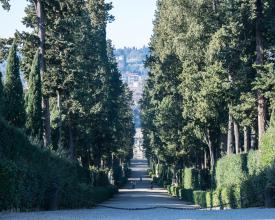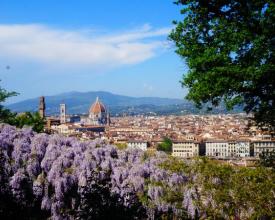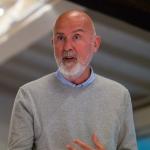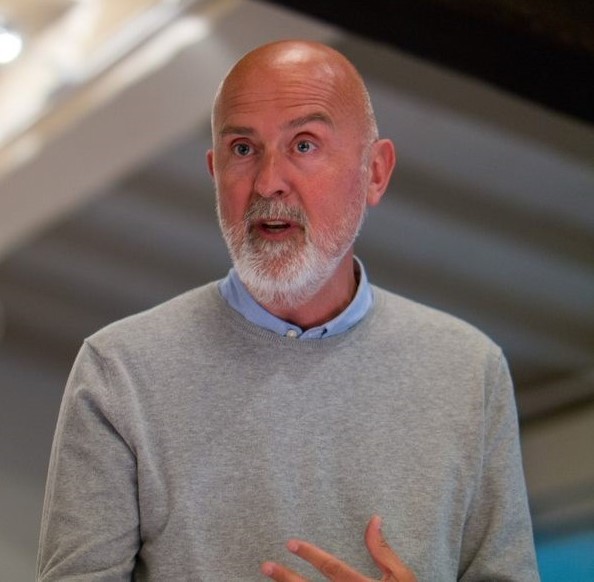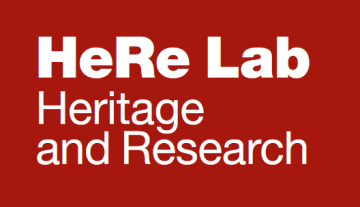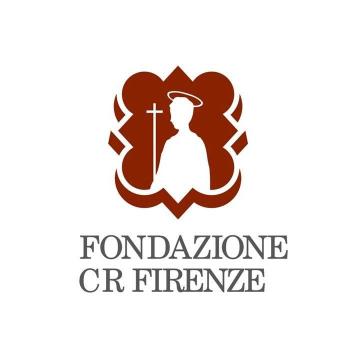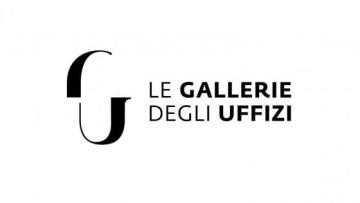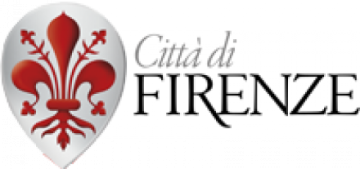
Vía Verde de Florencia: itinerarios ecológicos que conectan lugares y barrios de Florencia (Italia) declarados Patrimonio de la Humanidad
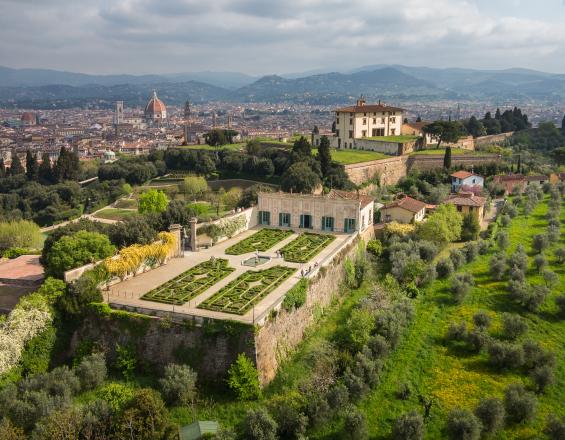
La Vía Verde de Florencia es un itinerario cultural y ecológico de 20 km situado en la zona de Oltrarno, un barrio al sur del "Centro Histórico de Florencia", declarado Patrimonio de la Humanidad. El proyecto pretende fusionar tres itinerarios ya existentes que atraviesan jardines y monumentos pertenecientes a distintas instituciones y a dos lugares declarados Patrimonio de la Humanidad ("Centro histórico de Florencia" y "Villas y jardines de los Médicis en Toscana"). El proyecto se enriquece con una serie de materiales informativos físicos y virtuales, así como con acciones encaminadas a la recalificación y restauración de componentes de los itinerarios. Este viaje único constituye una solución a largo plazo para ofrecer rutas alternativas centradas en el turismo lento, la sostenibilidad, el redescubrimiento de zonas verdes urbanas y el bienestar de los visitantes. Además, enriquece la relación entre el centro histórico, el paisaje que lo rodea y los barrios exteriores, sensibilizando sobre su importancia.
Contexto
Défis à relever
Retos medioambientales
- Contaminación urbana
- Escasa promoción y valorización de las zonas verdes urbanas, especialmente las situadas fuera del centro histórico
Retos sociales
- Turismo de masas que afecta al centro histórico y a su capacidad de carga
Retos económicos
- Subdesarrollo de los barrios y zonas aledañas al centro histórico, que tienen menos oportunidades económicas dada su ubicación fuera de los itinerarios turísticos tradicionales.
Ubicación
Procesar
Resumen del proceso
La creación de una Vía Verde en la ciudad de Florencia se sitúa en el marco más amplio de las Vías Verdes Europeas, concepto formalizado en la Declaración de Lille (2000) para potenciar la sostenibilidad urbana y el bienestar de los residentes y usuarios de las ciudades. La noción de paisaje urbano (BB1) y su relevancia para nuestras sociedades son la base sobre la que se asienta todo el proyecto, ya que expresa la necesidad de promover y restaurar los espacios verdes urbanos. El conjunto de asociaciones entre municipios, agentes privados, sitios del Patrimonio Mundial y otras partes interesadas (BB2) abrió vías para la realización institucional y práctica del proyecto, que incluyó la realización de material promocional y la restauración de componentes físicos. Por último, se identificaron y establecieron los tres itinerarios de acuerdo con el concepto de "Promenadologie", una filosofía que ve el paseo como una herramienta para experimentar el entorno de formas alternativas (BB3), y la creación de un sistema estructurado de orientación y señalización (BB4) que condujo a la identificación, restauración y promoción de los componentes físicos e intangibles a incluir en el proyecto.
Bloques de construcción
El "campo urbano": un enfoque para conectar naturaleza y cultura
En los últimos años, el concepto de campo urbano está adquiriendo una importancia fundamental como forma de superar el tradicional dualismo entre ciudad y campo, fomentando enfoques holísticos. La creación de itinerarios que conectan las zonas verdes urbanas, el centro histórico de Florencia y las Villas de los Médicis constituye un enfoque acertado para experimentar los centros urbanos de forma sostenible y conectar el núcleo y la zona tampón de los dos sitios del Patrimonio Mundial. El "campo urbano" se ha convertido en una solución para abordar la necesidad de más espacios verdes dentro de las ciudades, al tiempo que sitúa el bienestar de los visitantes en su centro.
Factores facilitadores
Además del establecimiento y la creación de itinerarios físicos, el disfrute del paisaje urbano y la valorización de las zonas verdes urbanas son posibles gracias a las acciones de recualificación (por ejemplo, la restauración de las rampas gracias a los fondos aportados por la Fundación CRF en 2018). Tales iniciativas tienen como objetivo realzar el significado de los barrios no incluidos en los itinerarios tradicionales mediante la restauración y el mantenimiento de los componentes físicos, la instalación de señalización, así como una serie de actividades de investigación y promoción.
Lección aprendida
La inclusión de las zonas verdes urbanas en los procesos patrimoniales y los servicios culturales es una práctica que permite una comprensión holística y el disfrute de los espacios urbanos. En la actualidad, las ciudades se consideran no sólo como un conjunto de componentes construidos, sino también como la interrelación entre la naturaleza y los hombres. Por tanto, el bienestar de los residentes puede mejorarse mediante la provisión y valorización de espacios verdes, permitiéndoles disfrutar de experiencias alternativas, sostenibles y ecológicas.
Creación de asociaciones interinstitucionales entre autoridades, partes interesadas y sitios del Patrimonio Mundial
La Vía Verde de Florencia se caracteriza por la fructífera coordinación de organismos de investigación, el Ayuntamiento de Florencia, agentes privados e instituciones patrimoniales, que han formalizado una asociación interinstitucional para gestionar, mantener y promover el proyecto. Los socios implicados son la Asociación "Firenze Greenway", la Fondazione Parchi Monumentali Bardini e Peyron, HeRe Lab - Heritage Research, el Ayuntamiento de Florencia (Departamento de Turismo, Dirección de Actividades Económicas y Turismo, Dirección de Cultura y Deporte, Departamento y Dirección de Medio Ambiente, Oficina del Patrimonio Mundial de Florencia y relaciones con la UNESCO), la Fondazione CR Firenze y la Galería de los Uffizi.
Factores facilitadores
El sistema de gobernanza y las asociaciones entre las partes interesadas se formalizarán mediante un protocolo de acuerdo y un sistema integrado de venta de entradas, así como un itinerario por los jardines pertenecientes a diversas instituciones: el Jardín Bardini (Fondazione CR Firenze), los Jardines de Boboli (Galería de los Uffizi) y el Jardín Bobolino (Ayuntamiento de Florencia).
Lección aprendida
La Vía Verde es un proyecto de éxito que reúne a distintas instituciones privadas y públicas a través de un Memorando de Entendimiento planificado y un billete integrado. La implicación de todas las partes e interesados ha garantizado que los itinerarios incluyan todos los componentes naturales y culturales que los constituyen.
La "promenadología" como filosofía para experimentar los lugares patrimoniales de formas alternativas
La aplicación de principios relacionados con el turismo lento y la creación de tres itinerarios verdes urbanos (uno centrado en la ciudad de los Medici, otro en los componentes medievales y otro en las colinas y el entorno circundante) también se ha relacionado con el concepto de "Promenadologie", la ciencia del paseo, una filosofía para mejorar las percepciones y experiencias medioambientales a través del paseo. En el caso de la Vía Verde, la "Promenadologie" constituye una forma alternativa de experimentar la conexión entre los dos sitios del Patrimonio Mundial, así como las relaciones entre elementos naturales y culturales, sólo a pie o en bicicleta. El paseo se convierte en una poderosa herramienta para reflexionar sobre las cualidades estéticas y sensoriales del patrimonio y la naturaleza, tendiendo un puente entre los visitantes y el entorno circundante.
Factores facilitadores
El disfrute de elementos naturales y culturales a pie y en bicicleta, y en concreto a través de paseos, es posible gracias a la creación de itinerarios ad hoc que conectan jardines y zonas verdes seleccionados y ya conocidos por sus características estéticas. Los itinerarios conectan los jardines Bardini, Boboli y Bobolino, pasando por las colinas del barrio de Oltrarno y la Villa di Poggio Imperiale. El paseo se ve reforzado por la ausencia de contaminación y tráfico, lo que sitúa el bienestar de los visitantes en el centro del proyecto.
Lección aprendida
El establecimiento de conexiones entre bienes declarados Patrimonio de la Humanidad, jardines urbanos e históricos y barrios menos conocidos mediante un itinerario a pie ha demostrado ser una estrategia acertada para fomentar viajes sostenibles y únicos. La ciencia del paseo (Promenadologie) permite fomentar el turismo lento y ecológico, el desarrollo económico y sostenible de distintas partes de la ciudad fuera del centro y el bienestar de los usuarios, que no se ven afectados por los atascos de tráfico ni por la contaminación acústica y atmosférica. Además, los itinerarios promueven una nueva forma de vivir la ciudad sin dejarse estimular en exceso por los aportes sensoriales, las actividades y la información del centro histórico, fomentando una reflexión más sencilla e interna sobre el dualismo hombre/naturaleza.
Señalización e interpretación del patrimonio cultural y natural
El sistema de señalización de la Vía Verde se basa en el concepto de "wayfinding", un enfoque que pretende organizar los espacios para que los usuarios puedan recorrerlos fácilmente. En la Vía Verde, la orientación ha sido fundamental para maximizar la experiencia de los visitantes y mejorar su relación con el lugar. El enfoque también se ha visto favorecido por la instalación de señalización física guiada por la adopción de un Plan Director (2016) y la visibilidad dada por la creación de un sitio web, la elaboración de una guía en cuatro idiomas que también incorpora la campaña EnjoyRespectFlorence, la organización de visitas guiadas y la publicación de vídeos y folletos. La interpretación de los itinerarios se hace accesible también gracias a la restauración de sus atributos físicos, como las rampas, la recalificación de nuevos componentes, como el Forte Belvedere, y la producción de descripciones históricas insertadas en el sistema de señalización. Por último, la creación de un Laboratorio de la Vía Verde de Florencia reúne a estudiantes, licenciados y profesionales que colaboran en la planificación urbana y medioambiental del proyecto.
Factores facilitadores
La instalación de la señalización de interpretación y orientación fue posible gracias a la formalización del Plan Maestro tras el establecimiento de asociaciones interinstitucionales y la disponibilidad de apoyo financiero proporcionado por la Fundación CRF. Además, los principios de la Declaración de Lille (2000) guiaron los esfuerzos de institucionalización y composición de la Vía Verde; y, por último, las estrategias de comunicación y el sitio web mejoraron y ampliaron la accesibilidad de la información y la señalización.
Lección aprendida
Gracias a estas iniciativas, se ha mejorado la comprensión de los tres itinerarios que componen la Vía Verde y se ha difundido entre un público más amplio. Se ha puesto de relieve la importancia tanto de la señalización física como de la información virtual gracias a la página web ofrecida en italiano e inglés y a la elaboración de guías ad hoc en distintos idiomas. La planificación de los itinerarios y el correspondiente sistema de señalización abren también nuevas vías para la inclusión de componentes adicionales que enriquezcan los itinerarios, expuestos así a positivos trabajos de restauración y recalificación. Un ejemplo es el Forte del Belvedere, una fortaleza que se benefició de un cambio de propiedad: como bien público, el edificio está ahora abierto al público, añadiendo valor al proyecto y constituyendo una de las principales atracciones de la Vía Verde. Por último, la pandemia de COVID-19 ha puesto de relieve la importancia de estos espacios verdes urbanos para el bienestar de los residentes y usuarios de la ciudad, cuya trascendencia se ha comunicado adecuadamente en plataformas virtuales.
Impactos
Impacto medioambiental
- Recalificación y restauración de elementos del itinerario anteriormente descuidados y pasados por alto.
- Redescubrimiento de paisajes agrícolas y culturales y de espacios verdes urbanos, con la consiguiente promoción de categorías de patrimonio y narrativas infrarrepresentadas.
Impacto social
- Promoción de itinerarios sostenibles y alternativos tanto para residentes como para visitantes, en el marco de un turismo lento para implantar una ciudad segura y saludable. La Vía Verde contribuye a mejorar las condiciones de salud, con buenos beneficios económicos
- Mejora de la salud y el bienestar psicosocial tanto de residentes como de visitantes y usuarios de la ciudad
- Restablecimiento de la relación entre la ciudad y su entorno, reforzando la conexión entre naturaleza y cultura
- Creación de una vía verde que conecta dos lugares declarados Patrimonio de la Humanidad, el Centro Histórico de Florencia y las Villas de los Médicis.
- Mejora de la comunicación entre las distintas partes interesadas y de la conexión entre las personas y los lugares.
Impacto económico
- Mejora de la gestión de los flujos turísticos
- Mejora del desarrollo económico de la zona de Oltrarno, fuera de los circuitos turísticos tradicionales del centro histórico.
Beneficiarios
- Ciudadanos de Florencia (residentes y usuarios de la ciudad)
- Visitantes
- Estudiantes y universitarios
- Usuarios de la ciudad con movilidad reducida
Objetivos de Desarrollo Sostenible
Historia
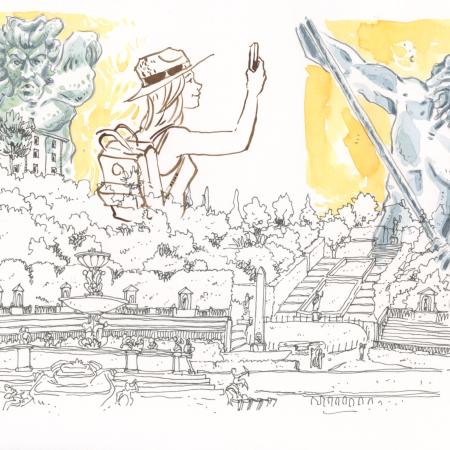
"Il taccuino del viaggiatore - Una giornata nella Greenway" es un cuento ilustrado por Gabriele Genini y escrito por Maria Chiara Pozzana, un testimonio de la experiencia de navegar por la Vía Verde y beneficiarse de sus valores medioambientales y culturales. El relato ha sido escrito mientras se recorría la Vía Verde y se disfrutaba de sus itinerarios culturales, históricos y ecológicos.
La publicación puede encontrarse en: https://www.firenzegreenway.com/il-taccuino-del-viaggiatore/

